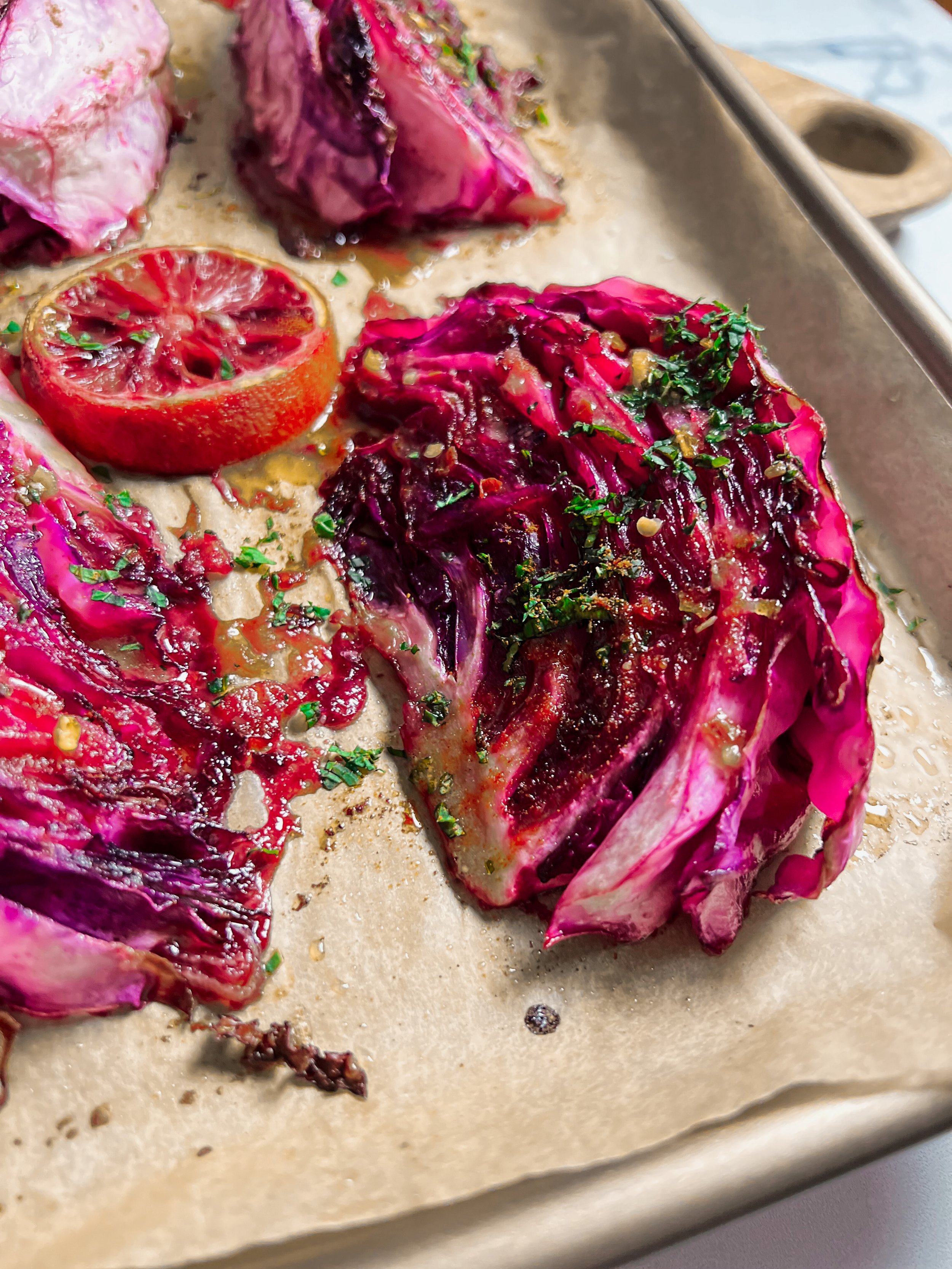Cabbage 101 | Health Benefits + Delicious Ways to Enjoy Green, Red & Napa Cabbage
Hi friends, Megan K. here with your guide to cabbage, everything you need to know about these Brassicaceae family beauties.
Cabbage is a versatile, nutrient-packed vegetable that comes in several varieties, each offering unique flavors, textures, and health benefits. Whether it’s the classic crunch of green cabbage, the vibrant color of red cabbage, or the tender leaves of Napa cabbage, this humble veggie deserves a spot in your kitchen. Let’s explore the health benefits of each type of cabbage and how to enjoy them in creative and delicious ways.
Health Benefits of Cabbage
Rich in Nutrients
Cabbage is low in calories and packed with vitamins and minerals, including:
Vitamin C: Supports immunity and skin health.
Vitamin K: Essential for bone health and blood clotting.
Fiber: Promotes digestion and gut health.
Loaded with Antioxidants
Cabbage is rich in antioxidants like polyphenols and sulfur compounds, which help fight inflammation and protect against chronic diseases.
Heart Health Booster
Red cabbage, in particular, contains anthocyanins that are linked to lower blood pressure and reduced heart disease risk.
Supports Digestion
The high fiber content in all types of cabbage helps promote regular digestion and a healthy gut microbiome. Fermented cabbage, like sauerkraut or kimchi, provides probiotics for added digestive benefits.
Cancer-Fighting Properties
Cabbage contains glucosinolates, sulfur-containing compounds that have been studied for their potential cancer-fighting properties.
Green Cabbage — The Classic Choice
Flavor Profile: Crisp, mild, and slightly peppery, green cabbage is the most common variety. Its sturdy leaves make it ideal for a variety of cooking methods.
Best Ways to Eat Green Cabbage:
Coleslaw: Toss shredded green cabbage with carrots, mayo, and vinegar for a classic coleslaw.
Stir-Fry: Add chopped green cabbage to stir-fries with soy sauce and garlic for a quick, healthy side.
Cabbage Soup: Use green cabbage in hearty soups or stews for added texture and nutrients.
Stuffed Cabbage Rolls: Wrap seasoned meat or grains in steamed cabbage leaves for a comforting dish.
Red Cabbage — The Nutrient Powerhouse
Flavor Profile: Slightly sweeter and more peppery than green cabbage, with a vibrant purple hue that adds a pop of color to dishes.
Best Ways to Eat Red Cabbage:
Raw in Salads: Shred red cabbage into salads for a crunchy, colorful addition. Pair it with apples and walnuts for a sweet-savory combination.
Pickled Red Cabbage: Quick-pickle red cabbage with vinegar, sugar, and spices for a tangy topping on tacos or sandwiches.
Braised Red Cabbage: Simmer red cabbage with apple cider vinegar, onions, and a touch of sugar for a traditional German-inspired side.
Roasted Red Cabbage, Blood Orange Miso Glaze with Mint:
Ingredients:
1 head of red cabbage
1 blood orange, sliced into medium rounds
1 shallot, sliced thin
Large bunch of mint, finely chopped
Red chili flake
Miso Glaze Ingredients:
¼ cup sake
¼ cup mirin
¼ cup white miso paste
3 tbsp granulated sugar
Directions:
Preheat oven to 425°F. Line a large baking sheet with parchment paper. Cut cabbage in ½ vertically, so ½ of the core is exposed. Place the flat side of the cabbage down, cut into 1" angle "wedges" - so the inner part of the cabbage is still connected to the core holding it together. Meanwhile in a medium saucepan bring sake & mirin to a boil, boil for 20 seconds to evaporate the alcohol. Turn heat to low, add miso & whisk. Once smooth, turn heat to high again & add sugar, whisking constantly so sugar doesn't burn. Remove from heat when sugar is fully dissolved. Cool to room temperature. Place wedges, blood orange & shallot slices on baking sheet. Drizzle generously with miso glaze & sprinkle red chili flakes on top. Bake for 20 minutes, or until some of the edges of the cabbage are browned & crispy. Remove from the oven, add a generous amount of chopped mint, serve warm as a side, in a salad or as a main over rice, Enjoy!
Napa Cabbage — The Delicate All-Rounder
Flavor Profile: Mild and slightly sweet, Napa cabbage has tender, pale green leaves and a subtle crunch. It’s commonly used in Asian cuisine.
Best Ways to Eat Napa Cabbage:
Stir-Fry or Hot Pot: Add Napa cabbage to stir-fries, soups, or hot pots for a tender, flavorful addition.
Salads: Use Napa cabbage as a lighter alternative to lettuce in salads or slaws.
Cabbage Wraps: Replace tortillas or bread with Napa cabbage leaves for a low-carb wrap option.
Kimchi: Ferment Napa cabbage with garlic, chili paste, and spices to make the famous Korean side dish.
Tips for Choosing & Storing Cabbage
Choose Fresh Heads: Look for firm, dense heads with vibrant leaves. Avoid any with soft spots or discoloration.
Store Properly: Keep cabbage in the crisper drawer of your refrigerator for up to two weeks. Napa cabbage may have a slightly shorter shelf life.
Prep with Care: Rinse leaves thoroughly to remove any dirt or debris before slicing.
The Versatility of Cabbage
Whether you’re adding green cabbage to a slaw, roasting red cabbage, or fermenting Napa cabbage into kimchi, each variety brings unique flavor and health benefits to your meals. Low in calories, high in nutrients, and endlessly versatile, cabbage is a simple yet powerful ingredient to include in your diet.
Try these ideas to make cabbage a star in your kitchen—and reap the many health benefits it has to offer!











